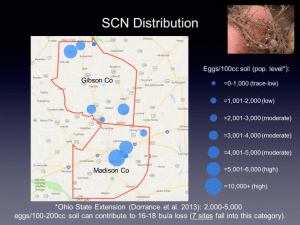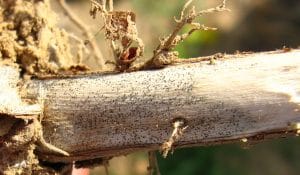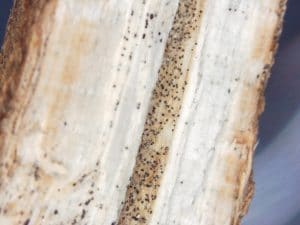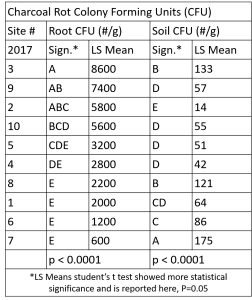Last week’s article discussed soilborne pathogens as ‘silent yield robbers’ of crops in production fields and the importance of screening. This article elaborates on two of the most common pathogens found in soybean fields, soybean cyst nematode (SCN) and charcoal rot, and presents the results from our 2017 soil screening. If you missed last week’s blogpost, access it here to learn more about our free soil screening program for 2018.
Fall is the ideal time to screen for soilborne pathogens as population detection at harvest can inform management options for spring planting. For example, SCN can be doubly detrimental as this pathogen can have a compounding effect with other soilborne pathogens (e.g. sudden death syndrome) by providing an entry point into the host plant via feeding lesions of the nematodes. In this way, nematodes can exacerbate issues from existing pathogens in a field and lead to increased yield loss. Soybean cyst nematode is the most damaging pathogen of soybean in North America (A Farmer’s Guide to Soybean Diseases, p. 99), and therefore early detection and management are key to curbing the effects of this pathogen. To detect SCN, soil is processed to remove the nematodes and/or the cysts (female nematode body filled with eggs). Cysts are then ground to release eggs, and the eggs are counted after being dyed for easier viewing and populations are reported as eggs per 100 cc of soil.
The small screening done in 2017, thanks to county agents and producer participation, showed that SCN populations can range across geographies (Image 1). While HG Type testing or Race testing was not completed in 2017, 2018 samples that contain SCN will also be HG Type/Race tested (watch for next week’s article to explain more about what this testing is and why it is important).

Management strategies for SCN include choosing resistant soybean varieties, using available seed treatments, rotating crops, and implementing cultural practices to reduce plant stress. One great resource is the variety trials UT conducts and results are posted at search.utcrops.com/ and specific ratings for SCN resistance can be found in the disease tables of soybean trials and the searchable soybean disease database found at search.utcrops.com/disease/.
Another economically important disease of soybean is charcoal rot caused by the fungal pathogen Macrophomina phaseolina (Image 2 and 3). This fungus has a broad host range of over 200 species of plants including both soybean and corn. Therefore, if a field is in soybean-corn rotation in an area with a population of M. phaseolina, then these crops are at a higher risk from increased levels of this pathogen on accumulated debris in the soil line that serves as inoculum for the next planted crop.


In 2017, all of the 10 fields across 2 counties in West Tennessee that we screened were positive for charcoal rot. Similar to SCN, soil is ground and then plated on media to allow the pathogen to grow out. It grows in colonies on the media and hence the population is reported as colony forming units per gram of soil (CFU/g).

Charcoal rot is a drought loving disease that prefers the hot dry weather that we receive in the Midsouth. For these reasons, it is important to monitor presence of this fungus in the fall in order to make decisions on integrated pest management (IPM) strategy for the spring. This may include choosing a resistant crop variety, rotating to a non-host crop (e.g. wheat), practicing no-till to conserve soil moisture, irrigating the field and/or managing SCN population if present.
It is important to monitor fields even if symptoms are not readily apparent above the soil line as these pathogens can still cause yield loss without showing foliar symptomology. Take advantage of our free soil testing this fall for all Tennessee farmers ($15 for out-of-state samples) by filling out the form here that includes soil sampling instructions. After samples are received and processed, our lab will communicate nematode results via email. Charcoal rot analysis will be part of a larger study this fall at WTREC, and those results will be available later this year. Again more information on the sampling and pathogens can be found in the previous blog article (Free Soil Testing for Pathogens) at news.utcrops.com.
For more information contact your local county agent or Heather Kelly, Plant Pathologist (UT), by email (youngkelly@utk.edu) or phone (731-425-4713).
Send soil samples to:
Plant Pathology Lab C
WTREC
605 Airways Blvd
Jackson, TN 38301


One thought on “Soilborne Pathogen Screening: 2017 Results and 2018 Screening”
Comments are closed.